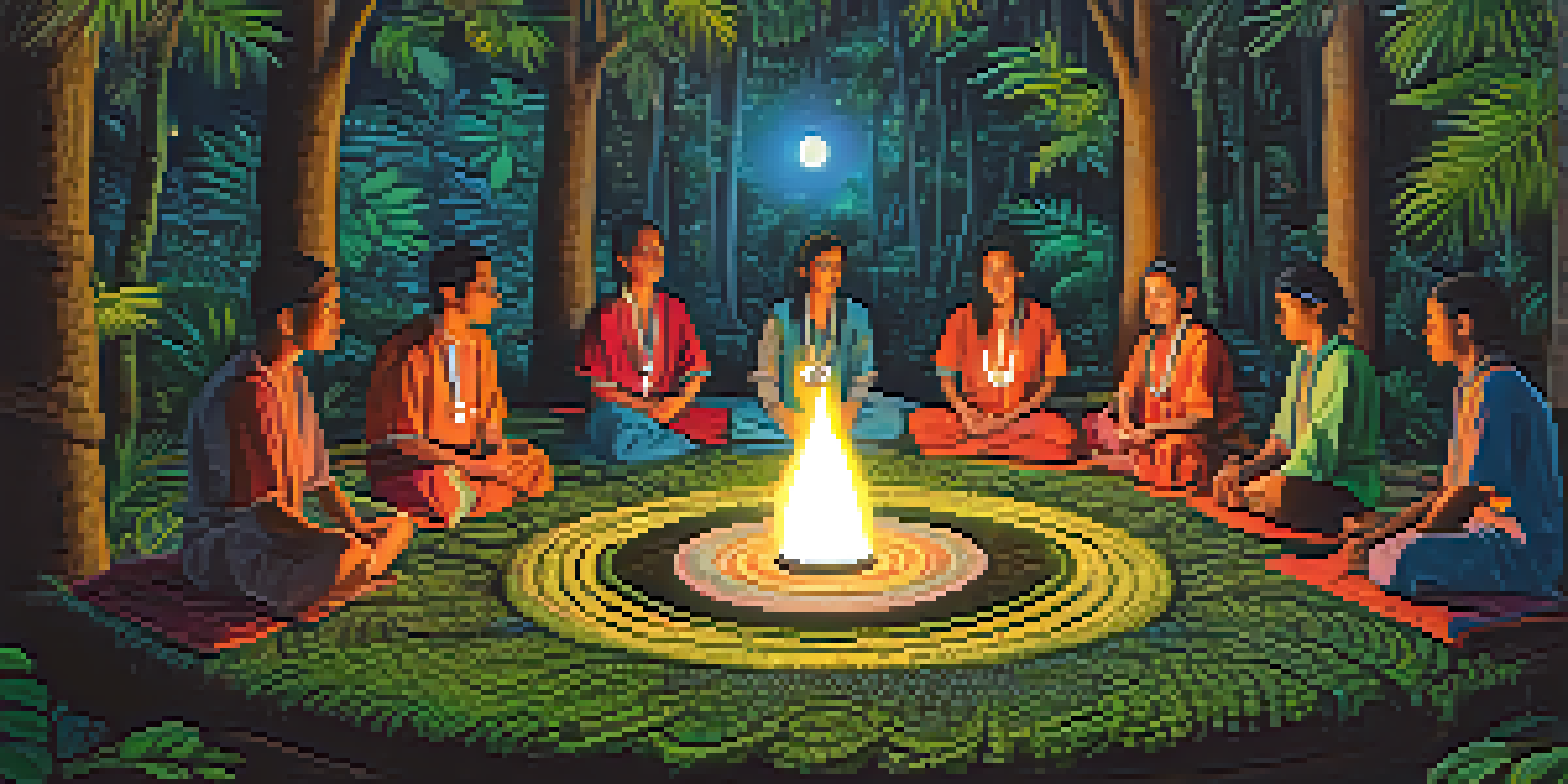Exploring Ayahuasca: A Journey into the Nature of Reality

What is Ayahuasca and Its Origins?
Ayahuasca is a powerful plant-based brew traditionally used by indigenous tribes in the Amazon rainforest. Made from the Banisteriopsis caapi vine and the Psychotria viridis leaf, it has been utilized for centuries in spiritual ceremonies. The brew is known for its hallucinogenic properties, enabling users to delve deep into their consciousness and explore the nature of reality.
The experience of Ayahuasca can lead to profound insights and transformation, allowing individuals to confront and heal their inner struggles.
Historically, shamans have led Ayahuasca ceremonies, guiding participants through their journeys with the help of rituals and songs. These experiences are often viewed as a rite of passage, offering insights into one's life and purpose. The cultural significance of Ayahuasca extends beyond mere exploration; it's a tool for healing, community bonding, and spiritual awakening.
Today, Ayahuasca has gained popularity beyond its native regions, attracting individuals from all walks of life seeking transformation. As more people travel to South America to partake in these ceremonies, understanding its origins becomes crucial for respecting the traditions and the wisdom of the indigenous cultures.
The Science Behind Ayahuasca Experiences
When consumed, Ayahuasca interacts with the brain's serotonin receptors, particularly the 5-HT2A receptor. This interaction can lead to vivid visual and auditory hallucinations, altered states of consciousness, and profound emotional experiences. The combination of the two main ingredients—DMT and MAOIs—creates a unique experience that can last for several hours.

Research into Ayahuasca has revealed its potential therapeutic benefits. Studies suggest that it may help alleviate symptoms of depression, anxiety, and PTSD by allowing individuals to confront and process underlying issues. This medicinal aspect is drawing increasing interest from the scientific community, as they explore its applications in mental health treatment.
Ayahuasca's Cultural Significance
Ayahuasca is a traditional brew used by indigenous tribes for spiritual healing and community bonding.
However, it's essential to approach Ayahuasca with caution. The experiences can be intense and may not be suitable for everyone, especially those with certain medical conditions or mental health issues. Understanding the science behind Ayahuasca helps prepare individuals for what to expect and encourages a respectful approach to its use.
Preparing for an Ayahuasca Ceremony
Preparation for an Ayahuasca ceremony is vital to ensure a safe and meaningful experience. Participants are often advised to follow a specific diet known as the 'Ayahuasca dieta,' which typically includes avoiding alcohol, caffeine, and certain foods. This diet helps to cleanse the body and mind, making the effects of the brew more profound.
To understand Ayahuasca is to respect its origins and the wisdom of the cultures that have preserved its use for centuries.
Beyond dietary restrictions, mental and emotional preparation is equally important. Practicing meditation, journaling, or engaging in self-reflection can help individuals set intentions for their journey. By clarifying what they hope to gain from the experience, participants can approach the ceremony with a more focused mindset.
It's also beneficial to research and choose a reputable shaman or retreat center. A skilled guide can help navigate the often challenging emotional landscapes that arise during the ceremony, ensuring that participants feel supported throughout their journey. This preparation lays the groundwork for a transformative experience.
What to Expect During the Ceremony
An Ayahuasca ceremony typically takes place in a safe, controlled environment, often held at night to enhance the experience. Participants gather in a circle, and the shaman begins by blessing the space and calling on spirits for guidance. After consuming the brew, individuals may start to feel its effects within 30 to 60 minutes.
The journey can involve a variety of experiences, from intense visual hallucinations to deep emotional processing. Some participants report encountering profound insights or engaging in conversations with otherworldly entities. It's crucial to remember that every experience is unique; what one person feels may differ significantly from another's journey.
Therapeutic Benefits Explored
Research suggests Ayahuasca may help alleviate symptoms of mental health issues like depression and PTSD.
Throughout the ceremony, participants may also experience physical reactions, including purging through vomiting or diarrhea, which is often considered a way of releasing toxins and negative energy. While these reactions can be uncomfortable, they are seen as part of the healing process, leading to a sense of release and renewal.
Post-Ceremony Integration: Navigating Insights
After the ceremony, the journey doesn't end; in fact, it often leads to a period of integration. This involves making sense of the experiences and insights gained during the ceremony. Many participants find it helpful to talk with others who shared the experience or seek guidance from the shaman to understand their revelations better.
Journaling can be a powerful tool during this integration phase. Writing down thoughts, feelings, and insights can help clarify the messages received during the journey. This reflection allows individuals to process their experiences and identify any changes they want to make in their lives.
Integration may also involve lifestyle changes, such as adopting healthier habits or pursuing spiritual practices. The insights gained can serve as a catalyst for personal growth, encouraging individuals to live more authentically and in alignment with their true selves.
Ayahuasca and Spiritual Awakening
Many people who participate in Ayahuasca ceremonies report experiencing profound spiritual awakenings. These moments can bring clarity about one's purpose, connections to the universe, and a deeper understanding of life itself. For some, it serves as a reminder of the interconnectedness of all beings.
These awakenings can lead to lasting changes in how individuals view themselves and their relationships with others. Participants often express feelings of love, compassion, and gratitude, fostering a greater sense of community and belonging. This shift in perspective can transform one’s approach to daily life.
Respecting Indigenous Practices
It's crucial to approach Ayahuasca ceremonies ethically, honoring the cultural traditions and communities involved.
However, it's essential to recognize that spiritual awakening is a personal journey and may not be immediate for everyone. Some may require multiple experiences to fully grasp their insights, while others may find a single ceremony enough to spark significant change. Embracing this journey with openness can lead to profound personal evolution.
The Importance of Respect and Ethical Considerations
As Ayahuasca grows in popularity, it's crucial to approach its use with respect and an understanding of ethical considerations. Many indigenous communities view Ayahuasca as sacred, and the commercialization of these ceremonies can undermine their cultural significance. It's essential to honor the traditions and practices of those who have long used the brew for spiritual healing.
When participating in Ayahuasca ceremonies outside of its traditional context, individuals should seek out ethical retreat centers that prioritize the well-being of their participants and the communities involved. This ensures that the experience is conducted respectfully and sustainably.

Additionally, being mindful of the potential impact on local communities is vital. Supporting local economies and respecting cultural practices can help foster a more ethical approach to experiencing Ayahuasca. Ultimately, understanding and respecting the roots of Ayahuasca can enrich one’s journey and contribute positively to the broader dialogue surrounding its use.